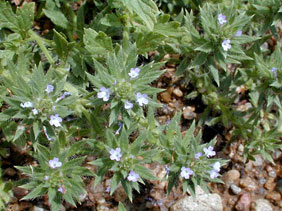PROSTRATE VERVAIN
|
 |
| File Size: 111 KB |
|
|
|
Verbena bracteata Lag. & Rodr.
|
| Konza Prairie, Riley County, Kansas |
| Annual or short-lived perennial |
| Height: Prostrate or decumbent |
| Family: Verbenaceae - Vervain Family |
| Flowering Period: June, July, August, September |
|
| Also Called: | | Bigbract verbena, large bracted vervain. | | Stems: | | Generally several from base,widely branched, prostrate or decumbent, rarely erect, 4-25 inches long, stiff-hairy. | | Leaves: | | Opposite, numerous, simple, lanceolate to ovate-lanceolate, .4 to 2.8 inches long and .25 to 1.2 inch wide, 3-lobed or sometimes pinnately incised, lateral lobes smaller than toothed central lobe, surfaces stiff-hairy. | | Inflorescences: | | Spike, terminal, 1 to 8 inches long, 2/5 to 4/5 inch in diameter, often ascending, stiff-hairy; bracts 1/3 to 3/5 inch long, 2-3 times as long as calyx. | | Flowers: | | Calyx 5-lobed, 1/8 to 1/6 inch long, stiff-hairy; corolla bluish to lavender or purple, 5-lobed, finely pubescent outside; stamens 5, arranged in 2 sets. | | Fruits: | | Nutlets 4, linear, 1/12 to 1/10 inch long, yellowish to reddish-brown, each 1-seeded. | | Habitat: | | Disturbed sites, waste areas, prairies, overgrazed pastures, lawns, and roadsides; all soil types. | | Distribution: | | Throughout Kansas. | | Forage Value: | | Prostrate vervain is rarely grazed by livestock. | | Uses: | | The Navajo used a poultice made from this plant to treat centipede bites. | | Comments: | | A common weed that will spread rapidly in disturbed areas. Very drought-resistant. The tiny flowers are almost hidden by the conspicuous bracts. |
|
| Prostrate vervain |  | | 105 KB | | Ottawa County, Kansas |
| | Prostrate vervain |  | | 154 KB | | Konza Prairie, Riley County, Kansas |
| | | |
|
|
|
|
|
|